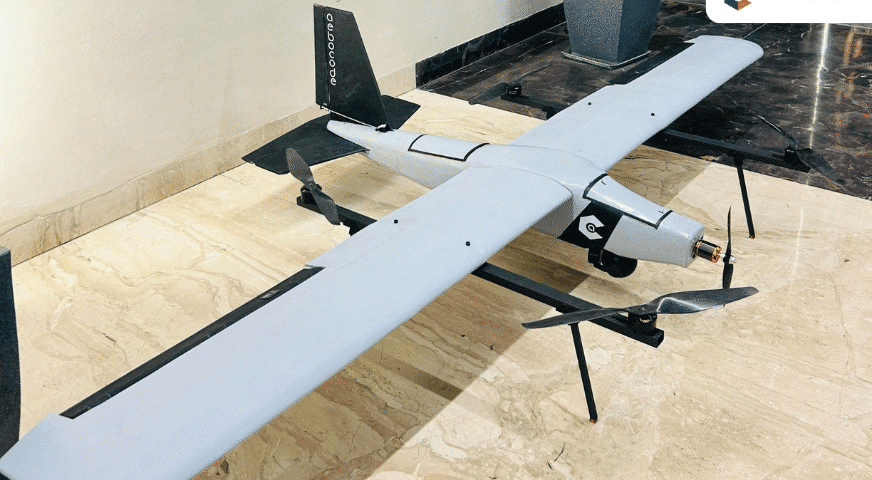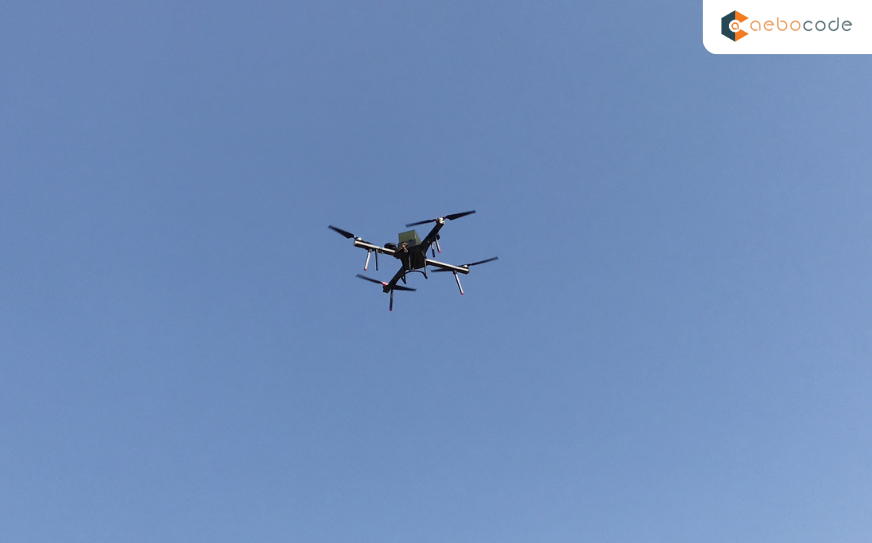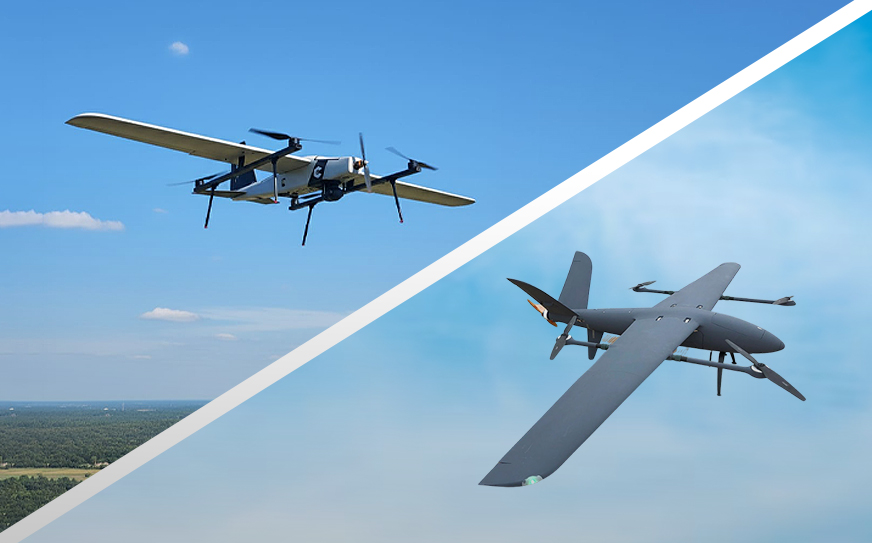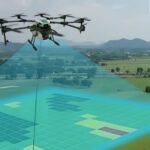
Mapping Drone Manufacturers: Guide to Airframes, Sensors and Mission Planning
September 24, 2025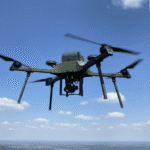
How India’s Drone Suppliers Fulfill Every Specification
October 27, 2025Hybrid VTOL Drones in India: What the Future of Aviation and Technology Holds
The world is witnessing a boom in the drones sector, and India is not an exception. Of all the types of drones, Hybrid VTOL drones are a revolution. Bringing the best of the fixed-wing and the multirotor drone, Hybrid VTOL drones are taking on a more important role in sectors like surveillance, agriculture, logistics, disaster management, and defense.
This blog discusses the term, technology, usage, and future potential of Hybrid VTOL drones in India.
What is a Hybrid VTOL Drone?
A Hybrid VTOL drone is an unmanned flying vehicle that can lift off and land vertically similar to a helicopter but one that also has the capability of flight in a horizontal fashion similar to a traditional airplane. A hybrid configuration brings the advantage of a rotary-wing drone’s maneuverability and a fixed-wing drone’s speed and range to drones.
Some of the prominent features of Hybrid VTOL drones are:
Vertical Take-Off and Landing: Reduces the need for runways or launch systems.
Fixed-Wing Flight: Delivers greater range, speed, and energy efficiency for horizontal flight.
Hybrid Propulsion Systems: Electric motors for vertical lift in some configurations, but internal combustion engines or other electric propulsion for forward flight.
Autonomous Capabilities: The majority of Hybrid VTOL drones incorporate autopilot, GPS guidance, and sophisticated sensors to enable autonomous or semi-autonomous flight.
How Hybrid VTOL Drones Function
Hybrid VTOL drones have two flight modes: vertical and horizontal.
Vertical Mode
The drone employs multiple rotors (usually four, six, or eight) to vertically land or take off. The mode is for stabilizing in confined areas and enables the drone to take off without the use of traditional runways.
Transition to Horizontal Flight
Once in the air, the quadcopter banks its rotors or switches to fixed-wing power, enabling it to glide very smoothly like an airplane. Transition is where the drone does not lose energy and efficient flight stability.
Horizontal Mode:
In forward flight, the quadcopter uses fixed wings for horizontal lift and speed during horizontal flight. This adds to flight time and cruising speed compared to traditional multirotor drones.
Such operational flexibility in both modes makes Hybrid VTOL drones extremely versatile to carry out missions involving precision hovering and range-extended surveillance.
Applications of Hybrid VTOL Drones in India
Hybrid VTOL drones are researched across various industries in India because of their versatility and operation benefits. Main applications are:
1. Defense and Surveillance
Defense in India has taken extremely serious interest in UAV technology. Hybrid VTOL drones are extremely useful for:
Border patrol: Capabilities of staying airborne over important positions and patrolling extensive distances at low cost.
Reconnaissance flights: Acquisition of current intelligence in distant or inaccessible areas.
Marine surveillance: Off-shore and seaboards monitoring.
The benefit of the union of fixed-wing flight with vertical take-off capability enables them to access distant places within a very short period regardless of standard airstrips.
2. Agriculture and Precision Farming
Indian agriculture is quickly adopting technology for increased productivity and efficiency. Hybrid VTOL drones facilitate:
Monitoring and mapping of crops
Pest attack and disease detection
Precision application of fertilizers and pesticides
Soil and water resource assessments
The vertical take-off and landing capability enables direct take-off and landing within farm fields, and fixed-wing mode provides the ability to cover large areas in a single flight.
3. Search-and-Rescue and Disaster Relief
Hybrid VTOL drones are particularly useful in natural catastrophes like floods, earthquakes, and landslides, which demand immediate response and reconnaissance. Hybrid VTOL drones are particularly useful for:
Providing medical aid or food to remote areas
Damage assessment mapping of disaster-stricken areas
Aiding search-and-rescue operations
Being an overall tool for India’s emergency personnel, their hovering capability in sensitive areas and ability to cover long distances make them invaluable.
4. Logistics and Delivery Services
With growing e-commerce and healthcare distribution, logistics in India is now being put to test using drones. Hybrid VTOL drones provide:
Timely last-mile delivery: Particularly to remote and inaccessible areas
Extended range: Rural and urban delivery points served economically
Operational versatility: Vertical takeoff from flat rooftops or small spaces without the necessity of landing pads
Businesses are looking towards drone-powered solutions to enable them to bypass traffic jams and reduce delivery time.
5. Environmental Monitoring
Conservation environment authorities are employing drones for:
Monitoring forest and animals
Monitoring air and water quality
Poaching surveillance
Hybrid VTOL drones possess high agility and endurance, hence high performance in constant monitoring of vast or tiresome ground.
Challenges in the Indian Context
In spite of all their glamour, the deployment of Hybrid VTOL drones in India is tainted with certain disadvantages:
Regulatory Framework:
Flights of UAVs are regulated by the Indian DGCA (Directorate General of Civil Aviation). Permission is required for commercial use, and rules keep changing by the minute.
High Cost:
Hybrid VTOL drones are costly compared to regular multirotor drones as they utilize advanced technology and materials.
Technical Complexity:
Since hover-to-cruise transition is highly precise, it requires advanced control algorithms; therefore, the design and maintenance become more complicated.
Advanced technology drones need qualified experts, battery charging machines, and computer hardware for data processing.
Despite such challenges, the advantages often outweigh the obstacles. Consequently, Indian companies are striving to develop locally made Hybrid VTOL drones.
Future of Hybrid VTOL Drones in India
The future of Indian drones will be dynamic within the next few years. Hybrid VTOL drones will dominate thanks to their:
Versatility: Functionality in various industries and environments
Efficiency: Merging range flight and hovering
Innovation Potential: Facilitating autonomous flight and AI-based analysis
With Make in India and technology and defense independence being at the top of India’s priority list, Hybrid VTOL drone development will definitely pick up steam. Startups as well as existing companies are already preparing to build drone variants for Indian conditions with an eye on cost, ruggedness, and performance.
Conclusion
VTOL hybrid drones are a technology revolution that merge the strengths of rotary-wing UAVs and fixed-wing aircraft. VTOL hybrid drones have gigantic potential in India to transform defense, agriculture, logistics, disaster response, and environmental monitoring. Yes, there are issues, but with increasing passion for drone technology and government-beneficial policies, India can be a global leader in the UAV market.
With constant innovation, Hybrid VTOL drones will lead to cost reduction and efficiency and give the complete scope of unmanned flight, and they will be a valuable asset to field commercially and strategically.



